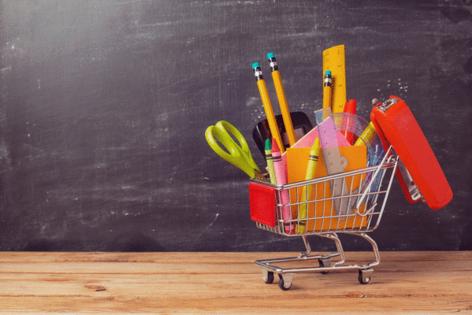Higher prices, evolving technology complicate back-to-school shopping
Published in Business News
Color-coded folders and notebooks. A fresh stash of pens and pencils. A new outfit.
Millions of American students from preschool through college, and their (often) bankrolling parents, back-to-school shop ahead of each fall. But as prices rise, technology evolves and new products hit the shelves, families are seeking ways to keep checking off the school supply list affordable.
“When I was young, I had $50 to go to the grocery store. I go now, and that’s, like, three or four items," said Matt Marsh, Minneapolis managing partner at Deloitte. “Everything costs more. So families are getting squeezed a bit, and it’s creating a level of anxiety.”
According to PwC’s inaugural back-to-school survey, nearly 3 in 4 parents said they’ll spend the same or more than they did last year on school supplies, even with higher prices and economic volatility.
“There’s still this underlying element of consumer confidence,” said Kelly Pedersen, a partner at PwC. “Even though we hear a lot of uncertainty in the market, people still need to shop for back-to-school.”
Plan and budget
Before shopping, take inventory of last year’s supplies. About a third of parents plan to reuse items, according to PwC.
Budgeting, paired with a specific shopping list, can prevent impulse buying.
In Minneapolis, parents Deloitte surveyed expected to spend $682 per child this year. That’s 20% more than the national average.
Niki Kroll of Minneapolis typically starts her back-to-school shopping in July and has already noticed higher prices. Various name-brand notebooks, folders and backpacks seem to be more expensive than previous years. But she has had success finding pencils, glue sticks and other basics on sale.
Those surveyed planned to spend less on clothing and more on school supplies. They also plan to spend more of their budget on tech than last year, though experts expect the total of those tech purchases to stay flat in comparison to last year’s $520 per family.
Assess need
As kids progress in school, more advanced classes might require new tech purchases, like a different calculator model, nearly each year. Delaying that purchase if possible or downgrading it — such as buying an older or used version — can free up room for more necessities like binders, scissors and pencil cases.
“Consider asking your child’s teacher what’s essential on day one vs. what can wait until later in the year,” wrote Ted Rossman, Bankrate senior industry analyst, in an analyst note.
Shop now
More than a third of parents PwC surveyed said they’re starting earlier this year to snag better prices and beat the rush.
“There’s this thought that the better deals are out there earlier before the heart of back-to-school in August,” Pedersen said.
Deloitte’s survey found more than two-thirds of Minneapolis parents plan to finish most of their school shopping by the end of July. They were able to cash in on recent sales like Target’s Circle Week and Amazon’s Prime Day. But several retailers are hosting back-to-school promotions through August.
Target announced Tuesday “Back-to-School-idays” discounts from July 27-Aug. 2. The retailer is maintaining its 2024 prices on key items, and some stores will have personalization stations with embroidery and patches for backpacks, lunchboxes, towels and pillows.
Walmart is offering lower prices than last year on select items, such as highlighters, erasers and notebooks.
Use AI
One in five parents told PwC they plan to use artificial intelligence to find the best deals this season.
“The biggest change we’ve seen with AI shopping is the agent concept, basically putting in your shopping list and budget to optimize your list and what you buy,” Pedersen said. “It’s really taking all of the searching work out of having to do back-to-school shopping.”
AI tools like app and website ChatGPT allow users to paste in a list of school supplies and make requests, like “find these items for the cheapest prices online or in-store within 20 miles of Minneapolis.” Users can also ask to search specific stores and keep the total under a certain amount.
Don’t fall for influencers
Deloitte’s data shows parents who use social media are likely to spend 1½ times more on back-to-school than others. Higher education, bigger wages, better access to the internet and more leisure time spent online all play a role.
“Generally, retailers are moving marketing dollars toward influencers, and influencers are creating behaviors that might result in that splurge purchase,” Marsh said.
More than two-thirds of Minneapolis parents said their child’s preferences often steer them to spend more, and 63% are willing to spend a little extra on their child’s first-day outfit compared with 57% nationally.
Make it fun
In Bloomington, Mall of America is hosting giveaways, limited-time promotions and events for back-to-school. Shoppers can scan the Mall of America app once per day for a chance to win a gift card or rewards points. The mall plans to give away more than $10,000 in gift cards between Aug. 11-31.
Deals are also available for the Nickelodeon Universe theme park and Crayola Experience from Aug. 4-Sept. 30.
“For parents and families coming to Mall of America, it’s a one-stop shop,” said Jill Renslow, Mall of America’s chief business development and marketing officer. “It’s a destination where people have that tradition of coming for not only shopping, but to go on some rides or grab lunch.”
Many cities also offer local events for free or low-cost school supplies, just look on city events calendars.
In store vs. online
Younger parents are leading a small resurgence of in-store shopping.
“Every year in our stats, Gen Zs are the ones who are visiting physical stores the most,” Pedersen said. “[They] value in-person experiences, and in some cases, they’re willing to pay a premium price for that.”
Gen Z also reported a higher likelihood of buying in-store. In previous years, younger shoppers more commonly browsed stores to try on or test products but made final purchases online.
Income also plays a role. Families earning under $75,000 are nearly twice as likely to shop only in-store, while higher-income households tend to prefer online shopping.
Be strategic
While inflation has cooled to 2.4%, prices are still up nearly 24% compared with pre-pandemic levels, according to Bankrate.
“It’s not like when the rate goes down, prices go down. They just don’t go up as fast anymore,” Marsh said. “But there’s a lot of economic anxiety about pricing.”
Looking for generic versions of favorite brands or comparing prices across stores can save money. So can thrifting, Pedersen said. About a fifth of shoppers said they’re looking to shop secondhand.
Shoppers can stack discounts by combining a rewards credit card with store promotions or other available offers, which can add up to considerable savings, Rossman wrote in an analyst note.
For Kroll, she enjoys letting her kids pick their most personal items, like lunchboxes. Despite higher prices, those moments are some of her family’s favorite memories.
“We really like shopping for backpacks and things that have more wiggle room for the kids’ own style. The lists have gotten quite specific, so it’s fun when they can pick out their own stuff,” Kroll said. “My son knows immediately what he wants, and my daughter tries on about 10 backpacks while looking in the mirror.”
©2025 The Minnesota Star Tribune. Visit at startribune.com. Distributed by Tribune Content Agency, LLC.












Comments